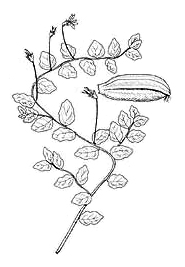Family: Campanulaceae
Pratia puberula
Citation:
Benth., Fl. Aust. 4:133 (1868).
Synonymy: Lobelia benthamii F. Muell., Syst. Census Aust. Pl. 1:85 (1882).
Common name: None
Description:
Delicate prostrate dioecious herbs, much-branched and mat-forming, rooting along stems, puberulent to glabrescent: leaves sessile, with a petiole up to 2 mm long, lanceolate to ovate, 3-7 x 2-5 mm, bluntly acute, with few widely spaced teeth each somewhat thickened at the apex, with few scattered hairs, glabrescent.
Flowers usually only a few borne singly in the axils of leaf-like bracts; male flowers abruptly constricted into a peduncle with a more or less aborted ovary, anthers purple with pollen; female flowers without pollen in the pale anthers; peduncles 4-12 mm long; sepals scarcely connate, the lobes linear-triangular, 1-1.5 mm long, clasping the corolla tube; corolla white tinged blue, 4-6 mm long, the basal tube split along the upper side, the linear-oblanceolate lobes subequal, glabrous; anther-column with short hairs around the terminal opening.
Moist places in scrub or woodland.

| Habit and anther column
|
Image source: fig. 625d in Jessop J.P. & Toelken H.R. (Ed.) 1986. Flora of South Australia (4th edn).
|
|
|
Distribution:
|
N.S.W.; Vic.
|
Conservation status:
native
Flowering time: Oct. — Nov.
|

SA Distribution Map based
on current data relating to
specimens held in the
State Herbarium of South Australia
|
Biology:
No text
Taxonomic notes:
Superficially very similar to, and often included under, P. pedunculata, but smaller and more delicate, corolla white and anthers without hairs on the upper cells. Intermediates between the two species have been recorded by Willis (1972) A handbook to plants in Victoria, p. 630 and two similar specimens from S.Aust. have unusually few hairs on the upper anther cells. This might indicate hybridisation between the two species.
Author:
Not yet available
|

